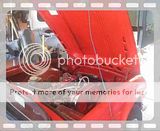T
Tinster
Guest
Guest
Offline
Maybe a really stupid question; maybe not.
I have never heard a real TR6 engine operating; only my own.
My cylinder pressure is 155 psi across the board
My manifold intake vacuum is 19psi and very constant.
All vacuum gauge tests indicate a healthy engine.
My timing is now at 12* advance, valves .010, plugs .025
New rocker shaft and refurbished rocker assembly.
Carbs tuned and balanced. Warm idle 800 to 900 rpm .
It has been suggested my engine top end is very loud
and I might have a problem. Does this engine sound "wrong"?
If so, what might be the cause? I have been driving this car
a whole bunch of miles and don't want to blow up the engine.
Thanks,
dale(tinster)

I have never heard a real TR6 engine operating; only my own.
My cylinder pressure is 155 psi across the board
My manifold intake vacuum is 19psi and very constant.
All vacuum gauge tests indicate a healthy engine.
My timing is now at 12* advance, valves .010, plugs .025
New rocker shaft and refurbished rocker assembly.
Carbs tuned and balanced. Warm idle 800 to 900 rpm .
It has been suggested my engine top end is very loud
and I might have a problem. Does this engine sound "wrong"?
If so, what might be the cause? I have been driving this car
a whole bunch of miles and don't want to blow up the engine.
Thanks,
dale(tinster)


 Hi Guest!
Hi Guest!

 smilie in place of the real @
smilie in place of the real @
 Pretty Please - add it to our Events forum(s) and add to the calendar! >>
Pretty Please - add it to our Events forum(s) and add to the calendar! >> 



 You could also install a sound proofing pad to the underside of the hood to help lower the decibles.
You could also install a sound proofing pad to the underside of the hood to help lower the decibles.
